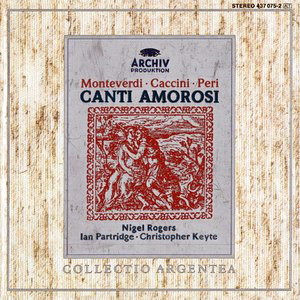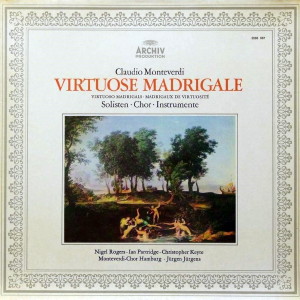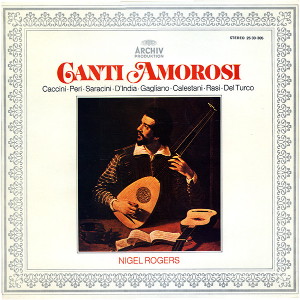 |
|
1 CD -
437 075-2 - (c) 1986
|
 |
| 1 LP -
2533 087 - (p) 1972 |
 |
| 1 LP -
2533 305 - (p) 1975 |
|
| CANTI AMOROSI |
|
|
|
|
|
| Claudio Monteverdi
(1567-1643) |
|
|
- Se vittorie sì
belle - (Tenor I/II;
harpsichord, lute, chitarrone,
viola da gamba, violone) *
|
2' 25" |
|
- Non voglio
amare - (Tenor I/II, bass;
virginal, harpsichord,
lute, chitarrone, viola da gamba,
violone) *
|
1' 13" |
|
- Vaga su spina
ascosa - (Tenor I/II,
bass; virginal, lute, chitarrone,
viola da gamba, dulciana, violone)
*
|
2' 47" |
|
- O mio bene, o
mia vita - (Tenor I/II,
bass; virginal, harpsichord, lute,
chitarrone, viola da gamba,
dulciana, violone) *
|
4' 01" |
|
- Zefiro torna e
di soavi accenti (Ciaccona) -
(Tenor I/II, bass; virginal,
harpsichord, organ, lute,
chitarrone, viola da gamba,
dulciana, violone) *
|
5' 37" |
|
-
Mentre vaga Angioletta - (Tenor
I/II; virginal, harpsichord,
lute, viola da gamba, violone) *
|
9' 00" |
|
|
|
|
| Giulio Caccini
(1551-1618) |
|
|
| - Perfidissimo
volto - (Tenor;
harpsichord, viola da gamba) |
3' 26" |
|
| - Belle rose
porporine - (Tenor;
harpsichord, chitarrone, viola
da gamba, violone) |
2' 51" |
|
|
|
|
| Sigismondo
d'India (c. 1582 - c.1627) |
|
|
| - Cruda
Amarilli - (Tenor;
chitarrone)
|
2' 27" |
|
| - Intenerite
voi, lagrime mie, quel duro core
- (Tenor; viola da gamba) |
2' 42" |
|
|
|
|
| Claudio Saracini
(1586 - after 1649) |
|
|
| - Io moro,
ecco ch'io moro - (Tenor;
harpsichord) |
3' 48" |
|
| - Deh, come
invan chiedete - (Tenor;
harpsichord) |
2' 15" |
|
| - Quest'amore,
quest'arsura - (Tenor;
chitarrone, violone) |
2' 12" |
|
|
|
|
| Jacopo Peri
(1561-1633) |
|
|
| - O durezza di
ferro e di diamante - (Tenor;
harpsichord, viola da gamba) |
1' 59" |
|
| - Tra le donne
anche s'onora - (Tenor;
harpsichord, chitarrone, viola
da gamba, violone) |
2' 41" |
|
|
|
|
Giulio Caccini
|
|
|
| - Udite, udite
amanti - (Tenor;
harpsichord, chitarrone, viola
da gamba, violone) |
1' 45" |
|
| - Amarilli mia
bella - (Tenor;
chitarrone) |
2' 45" |
|
|
|
|
| Marco da Gagliano
(1582-1643) |
|
|
| - Valli
profonde, al sol nemiche rupi
- (Tenor; positive, viola da
gamba, violone) |
4' 01" |
|
|
|
|
Claudio Saracini
|
|
|
| - Giovinetta
vezzosetta - (Tenor;
positive, chitarrone) |
1' 21" |
|
| - Da te parto,
cor mio - (Tenor;
harpsichord, viola da gamba) |
3' 39" |
|
|
|
|
Jacopo Peri
|
|
|
| - Bellissima
regina - (Tenor;
harpsichord, chitarrone, viola
da gamba, violone) |
2' 54" |
|
|
|
|
| Francesco Rasi
(1574-1621) |
|
|
| - Indarno Febo
il suo bell'oro eterno - (Tenor;
chitarrone) |
1' 42" |
|
|
|
|
| Giovanni Del Turco
(1577-1647) |
|
|
| - Occhi belli
e sia ver che in lungo pianto
- (Tenor; chitarrone, viola da
gamba) |
3' 23" |
|
|
|
|
| Vincenzo Calestani
(1589 - c. 1617) |
|
|
| - Damigella
tutta bella - (Tenor;
harpsichord, chitarrone, viola
da gamba, violone) |
2' 46" |
|
|
|
|
Nigel Rogers, Ian
Partridge, tenor *
|
Nigel Rogers, tenor |
|
Christopher Keyte, Bass
*
|
Colin Tilney, harpsichord
& positive |
|
Thomas Brandis,
Peter Brem, Solo violin *
|
Anthony Bailes, chitarrone |
|
Käthe Wagner, dulciana
*
|
Jordi Savall, viola
da gamba |
|
Heinrich Haferland,
viola da gamba *
|
Pere Ros, violone |
|
Klaus Storck, violoncello
*
|
|
|
Hans Koch, violone
*
|
|
|
Eugen M. Dombois, liuto
*
|
|
|
Michael Schäffer, chitarrone
*
|
|
|
Colin Tilney, virginal
& harpsichord *
|
|
|
Werner Kaufmann, organ
& virginal *
|
|
|
Jürgen Jürgens,
Direction *
|
|
|
|
|
|
|
Luogo
e data di registrazione |
|
-
Friedrich-Ebert-Halle,
Hamburg-Harburg (Germania) -
aprile 1971 (Monteverdi)
- Plenarsaal der Akademie der
Wissenschaften, München (Germania
- marzo 1975 |
|
|
Registrazione:
live / studio |
|
studio |
|
|
Producer /
Engineer |
|
Andreas
Holschneider - Gerd Ploebsch
(Monteverdi) - Heinz Wildhagen /
Klaus Hiemann (Monteverdi) - Heinz
Wildhagen |
|
|
Prima Edizione
LP |
|
-
Archiv - 2533 087 - (1 lp) -
durata 52' 30" - (p) 1972 -
Analogico - (Monteverdi -
parziale)
- Archiv - 2533 305 - (1 lp) -
durata 48' 37" - (p) 1975 -
Analogico - (intero)
|
|
|
Edizione
"Collectio" CD |
|
Archiv
- 437 075-2 - (1 cd) - durata 73'
44" - (c) 1986 - ADD |
|
|
Note |
|
- |
|
|
|
|
NEW SONGS
FOR OLD
In
1602 the virtuoso tenor
Giulio Caccini published a
collection of songs for
voice and basso continuo
with the banner-waving title
Le nuove musiche.
Caccini sought to impress
the world - and also his
employer, the Grand Duke of
Tuscany - with what he
claimed were entirely new
styles of solo song and solo
singing. Of course, this
“new music” was scarcely
new; but for all his
unacknowledged debts to
earlier traditions, Caccini
may have had a point. He
said that he was answering
recent humanist objections,
made in Florence and
elsewhere, that the
prevalent musical style of
the Renaissance -
contrapuntal writing for
several voices - only
confused both the words and
the emotions that music was
intended to arouse; hence
the use of a single voice
supported by an instrument
and the presentation of the
text in a declamatory,
affective manner. No less
important was the displaying
of the talents of the new
breed of singer-virtuoso at
his (sometimes her)
technical and expressive
best.
Le nuove musiche contains
both madrigals and arias.
The distinction was
primarily poetic - aria
texts are stophic - although
it also had musical
implications. Thus Caccini
writes serious
through-composed declamatory
madrigals alongside lighter
songs which are more
rhythmically and melodically
conceived and often in a
dance-like triple time:
“Perfidissimo volto” and
“Belle rose porporine”
(madrigal and aria
respectively) are
representative. The success
of these new styles and
techniques was such that
over 80 collections
containing solo songs had
been published by 1620.
Some were by the greatest
virtuosos of the age:
Francesco Rasi, who took the
title-role in Monteverdi’s first
opera, Orfeo (1607),
is a prime example. Others
catered for the domestic
market, where less
extravagant idioms were the
order of the day: the fine
collection of Madrigali
et arie (1617) by
Vincenzo Calestani from Pisa
- it also includes pieces by
Florentine musicians such as
Giovanni del Turco - was
expressly written for the
young noblewoman Isabella
Malespini-Mastiani. But a
few of these volumes were by
composers with more serious
pretensions who may have
felt that Caccini had
subverted the noble aims of
the “new music” with his
rather facile style. For
example, Caccini’s rival at
the Medici court, Jacopo
Peri, made few concessions
to virtuosity and sought, in
his madrigals at least, a
style thoroughly faithful to
their serious texts by the
leading poets of the age.
The trend continued in the
works of composers no less
skilled in writing
“old”-style polyphonic
madrigals. Marco da Gagliano
and Sigismondo d’India had
several fine madrigal books
to their name, and they
brought to the solo song
much-needed expressive and
structural techniques honed
within the polyphonic
tradition. This in turn
granted the solo song a
solidity and expressive
power somewhat lacking in
songbooks by musicians who
were more singers than
composers. Sigismondo
d’India’s “Cruda Amarilli,
che col nome ancora”
exploits dissonances and
harmonic structures that
would not be out of place in
a polyphonic madrigal
(indeed, it draws on
d’India’s own five-voice
setting of the poem
published in 1606). As a
result, the solo madrigal
begins to parallel its
polyphonic counterpart,
rather than standing in
opposition to it. The rather
wayward songs of Claudio
Saracini, a noble amateur
from Siena, display the
chromaticism and rhythmic
irregularities typical of
the no less wayward
polyphonic madrigals of
Gesualdo, as music enters a
Mannerist phase.
Unlike Gagliano and d’India,
Claudio Monteverdi had
little truck with writing
for solo voice, at least
outside his operas. One
problem with the “new music”
for professional composers -
and Monteverdi was the
greatest of his generation -
was the fear of jettisoning
musical skills granted by
tradition and developed by
years of hard work. Caccini
claimed that he had learned
more from his humanist
friends than from three
decades of studying
counterpoint, but many who
really had studied
counterpoint for that length
of time saw little advantage
in denying a musical
heritage that was still an
effective measure of musical
worth. Monteverdi, a
musician at the court of the
Duke of Mantua and from 1613
head of the prestigious
musical establishment of St.
Mark’s basilica in Venice,
trod cautiously. Certainly
he was aware of newer
trends: “Mentre vaga
Angioletta”, from his Eighth
Book of Madrigals of 1638,
is a fine illustration of -
perhaps a satire on -
virtuosic vocal techniques.
But even when the pull of
the “new music” became
irresistible - and
Monteverdi was certainly
sympathetic to its aesthetic
roots - he sought to retain
the best of the “old” style,
in part by writing for more
than one voice; he explored
different combinations of
three voices for a time (for
example two tenors and
bass), but the duet seems to
have become his preferred
combination.
The lessons are clear in his
Seventh Book of Madrigals
(1617) - with the modern
title Concerto -
then his Scherzi
musicali (1632), the
magnificent Eighth Book,
headed Madrigali
guerrieri, et rzmorosi
(“Madrigals of War and
Love”), and the posthumously
published Ninth Book (1651).
All offer fine examples of
emerging Baroque musical
styles. In “Vaga su spina
ascosa” (Seventh Book)
Monteverdi takes a rather
facile aria text by
Gabriello Chiabrera and
constructs an impressive - and
significantly, through-composed -
musical edifice. “Se
vittorie sì belle” (Eighth
Book) is a splendid duet
counterpointing the images
of the book’s title, war
and love (of course, two
sides of the same coin),
with the strident rhythms
and martial fanfares of
his newly coined stile
concitato (the
“agitated style”).
The duet “Zefiro
torna e di soavi accenti”
(from the Scherzi
musicali) perhaps
best reveals Monteverdi’s
subversion of newer trends
for expressive ends. Here
the clichés of the
triple-time aria are
applied to a highly
literary sonnet (by
Ottavio Rinuccini), with a
bouncy melody played off
against (at the end)
plangent dissonances to
contrast the joys of
spring with the pains of
love. No less radical,
while not unprecedented,
is the repeating cadential
figure (the “ciaccona”
pattern) used as a ground
bass. Add the overtly
imitative musical gestures
(for “mountains”,
“valleys”, “murmuring
stream”, etc.) so often
used for word-painting in
the polyphonic madrigal,
and the result is a
striking fusion of old and
new that is in turn
Monteverdi’s remarkable
contribution to a
remarkable period in the
history of Western music.
Tim Carter
|
|